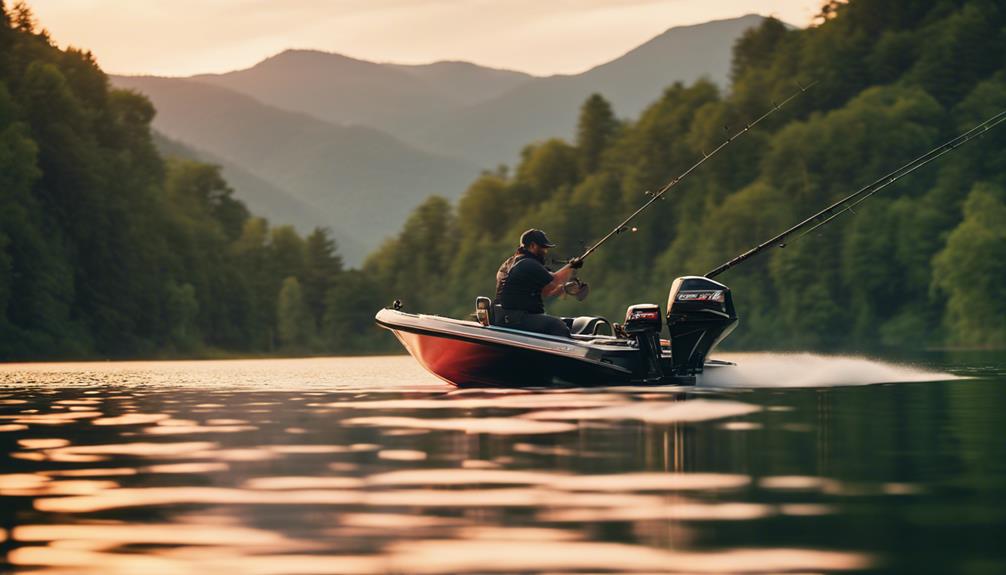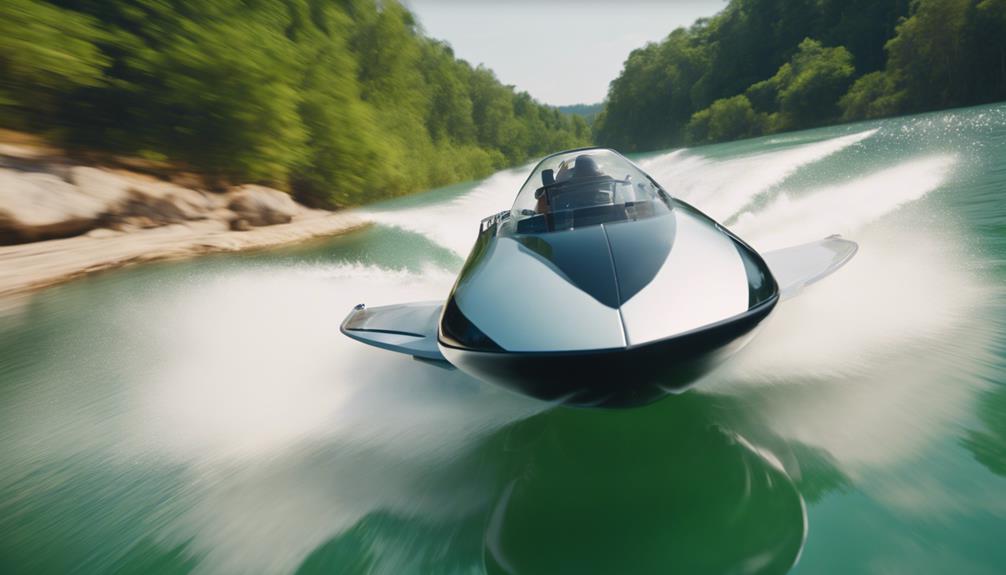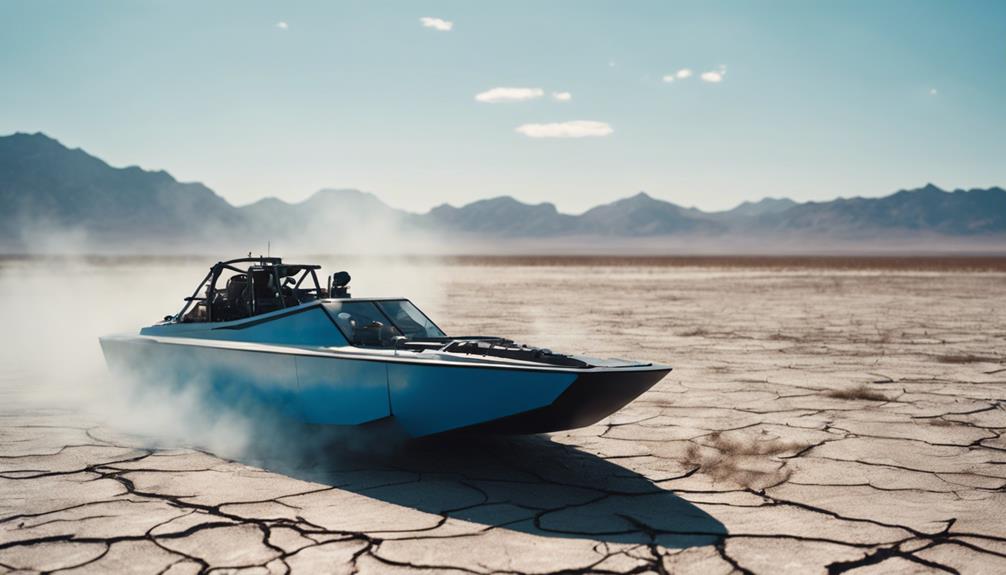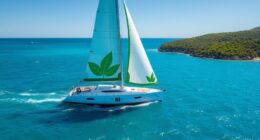Yes, you can definitely troll with a jet boat, which can actually enhance your overall fishing experience. To achieve the best results, maintain a steady speed between 1 to 1.5 mph and use lead weights to keep your bait submerged. Consider using a trolling motor to improve steering control, especially at low speeds. Fuel efficiency is important, so opt for a 4-stroke outboard engine. Remember to stay mindful of local regulations and fishing conditions. If you're looking for more tips on techniques and gear, there's plenty more to discover that can boost your trolling game!
Key Takeaways
- Trolling with a jet boat is effective, especially at speeds between 1 to 1.5 mph, enhancing bait placement and fish attraction.
- Using lead weights helps keep bait submerged below the jet wash, utilizing bubbles to attract fish.
- Installing a trolling motor improves handling and stability, addressing low-speed steering challenges common in jet boats.
- Regular maintenance of outboard engines, particularly 4-stroke types, ensures optimal fuel efficiency and performance during trolling.
Understanding Trolling Techniques
When trolling with a jet boat, it's vital to master key techniques that enhance your fishing success.
One of the first things you need to focus on is your trolling speed. Ideally, you should aim for a slow speed between 1 to 1.5 mph. This speed allows for better bait placement and keeps your bait in the best zone for attracting fish.
Another useful tactic is to utilize lead weights. By keeping your bait submerged beneath the jet wash, you'll take advantage of the bubbles and spray created, which can effectively draw in fish, especially silvers.
Additionally, employing the bucket method can help improve your steering control while trolling, making it easier to maintain a steady course, regardless of changing conditions.
You'll also want to pay attention to the local fishing conditions and adjust your techniques accordingly. Consistency in catching fish often hinges on your ability to adapt.
Remember, keeping your bait relative to the jet wash is vital; this simple adjustment can greatly boost your chances of success.
Jet Boat Steering Challenges
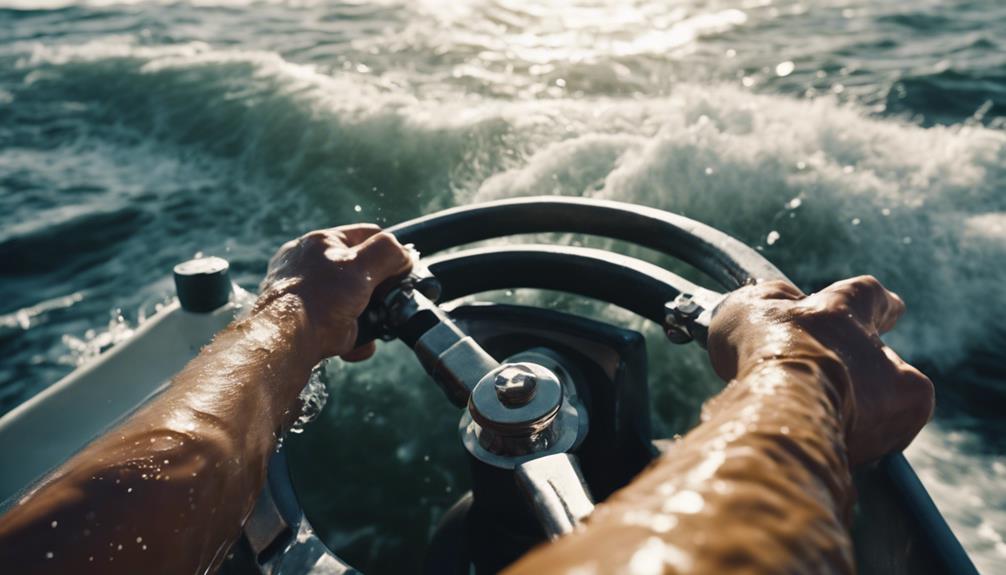
Jet boats often struggle with steering precision at low speeds, making it tricky to maintain control while trolling. Unlike docking, where precise movements are essential, the steering challenges during trolling can be managed with some techniques. Understanding these challenges will help you steer effectively.
| Challenge | Solution |
|---|---|
| Poor low-speed steering | Use full turn lock-to-lock steering |
| Crosswinds in crowded areas | Employ the bucket method |
| Difficulty maintaining control | Consider a trolling motor |
Using a trolling motor can also alleviate some steering difficulties, providing you with better handling and stability. The bucket method, which involves adjusting the jet's direction, can enhance your control when making turns or steering through tight spots.
Always be aware of your surroundings since crosswinds can complicate steering, especially in busy areas like Pony Cove. While trolling, focus on maintaining a steady speed and experiment with different techniques to find what works best for you and your jet boat. By mastering these steering challenges, you can enjoy a smoother and more efficient trolling experience.
Engine Types for Trolling

When you're trolling with a jet boat, choosing the right engine type is essential for success.
You'll want to take into account factors like outboard versus inboard motors, fuel efficiency, and the size of the motor to guarantee you're maximizing performance.
Let's take a closer look at these important aspects.
Outboard Vs. Inboard Motors
Choosing between outboard and inboard motors for trolling can greatly impact your fishing experience and efficiency on the water.
Outboard motors are generally preferred, especially outboard jet engines, due to their versatility and ease of maintenance. With a 4-stroke outboard engine like the DF115 Suzuki, you'll enjoy better fuel efficiency and lower emissions, which can enhance your trolling sessions.
On the other hand, inboard motors may lead to higher fuel costs and can be noisier, which might spook the fish you're trying to catch. If you're considering an inboard jet engine, keep in mind that it can complicate low-speed steering and fuel consumption, making it less ideal for prolonged trolling.
Additionally, using kicker motors alongside your primary outboard engine allows for better speed control, with some models reaching speeds of about 8 mph at full throttle—perfect for those slow, steady trolling trips.
Ultimately, your choice between outboard and inboard motors will depend on your boat's design, intended usage, and the specific hull shape, all of which can enhance performance under varying conditions.
Fuel Efficiency Considerations
Fuel efficiency plays an essential role in selecting the right engine type for trolling, as it directly influences your fishing experience and overall costs on the water.
When choosing between engine types, consider 4-stroke engines. They're preferred for trolling due to their superior fuel efficiency and lower exhaust emissions compared to 2-stroke engines, making them a more environmentally friendly option.
Additionally, using a kicker motor, typically ranging from 5 to 10 horsepower, can greatly enhance fuel efficiency while trolling. This setup allows for better speed control and reduces strain on your main engine, helping to manage fuel burn effectively.
You should also note that fuel consumption for boats with larger engines can vary widely. Some achieve about 2.75-3 miles per gallon, underscoring the importance of selecting the right motor for extended trips.
Regular maintenance, like checking spark plugs and the impeller, is vital for guaranteeing peak fuel efficiency.
Motor Size Recommendations
Selecting the right motor size is vital for effective trolling, as it directly impacts your control, speed, and overall fishing experience. When choosing a motor, consider the balance between power and precision. A secondary trolling motor in the 5-10 HP range can help you achieve better control, while your main motor (50-200 HP) may be too powerful for fine-tuning speeds.
Here's a quick comparison of different motor types:
| Motor Type | HP Range | Benefits |
|---|---|---|
| Kicker Motor | 5 – 10 HP | Emergency backup, speeds ~8 mph |
| Electric Bow-Mounted | Varies | Hands-free operation, ideal in wind |
| Standard Outboard | 20 HP | Improved speed, performance with plates |
| Smaller Outboard | 9.9 HP | Less control, suitable for smaller boats |
For peak performance, pair a 20 HP motor with trolling plates for enhanced efficiency. Regular maintenance, like checking spark plugs and the impeller, is vital to guarantee your motor remains in top shape for all your trolling adventures.
Fishing in Alaska Waters

When you're fishing in Alaska waters, understanding seasonal regulations is essential to protect the local fish populations.
Popular spots like the Kenai and Kasilof rivers offer fantastic opportunities to catch salmon and trout.
Make certain you have the necessary permits and adhere to local guidelines to guarantee a successful trip.
Seasonal Fishing Regulations
Fishing in Alaska requires you to stay updated on seasonal regulations that protect spawning fish and dictate permissible gear and methods. These regulations are vital for maintaining healthy fish populations and ensuring sustainable fishing practices. If you're planning to go trolling, it's important to know the specific rules that apply to the type of fish you're targeting and the waters you'll be fishing in.
For example, during the salmon season, which typically runs from late June to mid-August, you might need a special permit for dipnetting. However, if you're trolling, different rules may apply. Each species has its own season, and guidelines on the gear you can use can vary by location. Be sure to check local regulations to confirm what's allowed.
Additionally, remember that commercial fishing hours may also affect your plans. Always adhere to local regulations while boating, as they'll help you avoid fines and contribute to the preservation of Alaska's rich aquatic ecosystem.
Popular Fishing Locations
Alaska boasts an array of popular fishing locations, with the Kenai and Kasilof Rivers standing out for their exceptional salmon dipnetting opportunities during the peak season. From late June to mid-August, these rivers are teeming with salmon, making them prime spots for anglers looking to fill their coolers. When you're jet boating along these waterways, you can access some of the best fishing holes that are often unreachable by conventional boats.
In addition to salmon, Alaska's freshwater lakes and streams offer diverse species like trout, providing even more options for your fishing adventures. However, it's vital to stay informed about seasonal restrictions implemented to protect spawning fish. Familiarizing yourself with local regulations guarantees your fishing excursions are both successful and compliant.
Before you head out, make sure you've got a valid fishing license and any necessary permits. Remember, adapting your fishing techniques and bait choices to Alaska's unique environments will enhance your experience. Whether you're dipping nets or trolling with your jet boat, the Alaskan waters promise an unforgettable adventure!
Commercial Fishing Guidelines
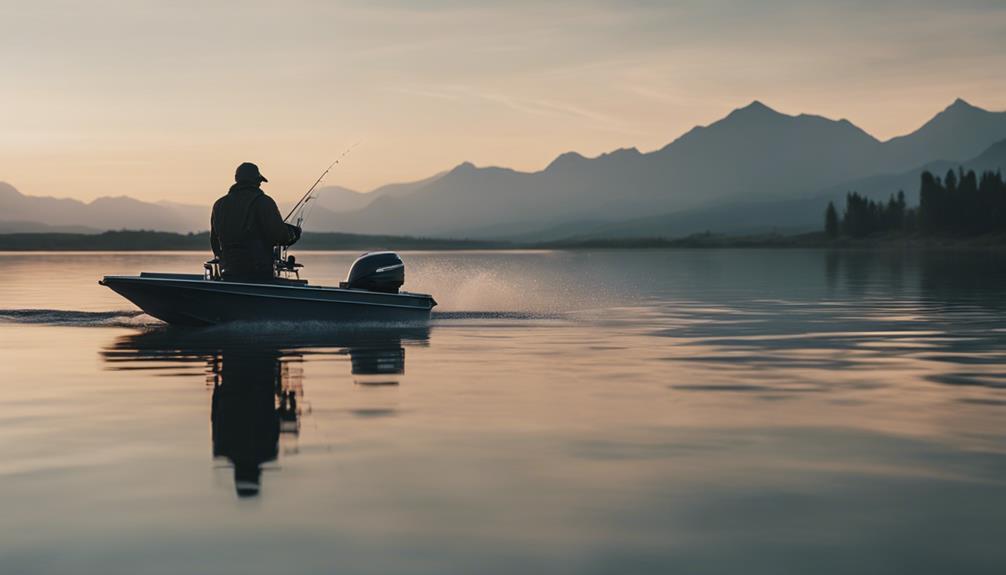
Understanding the commercial fishing guidelines is essential for ensuring compliance with regulations that protect both fish populations and the environment. If you're using a jet boat for commercial fishing, it's vital to be aware of specific rules that govern your activities.
Here's a quick overview of key guidelines:
| Guideline | Details |
|---|---|
| Weekly Fishing Hours | Typically range from 40 to 60 hours, varying by season and species. |
| Compliance | Mandatory adherence to state regulations and gear restrictions. |
| Permits | Required for certain watercraft, ensuring safety and environmental standards. |
| Environmental Laws | Govern fishing practices to maintain sustainable fish stocks. |
| Local Resources | Forums provide updates and community advice on regulations. |
Community Insights and Resources

Engaging with community forums can greatly enhance your trolling skills and jet boat performance by providing access to shared experiences and expert advice.
For instance, platforms like Jet Boating New Zealand, with over 5,400 members, offer valuable insights into various trolling techniques and setups specifically tailored for jet boats. You'll find discussions on which methods have worked best in different conditions, helping you avoid common pitfalls.
Local fishing forums are another fantastic resource, where you can learn from others' successes and challenges. Many experienced anglers recommend participating in community events to gain hands-on knowledge and firsthand tips that can optimize your jet boat's performance.
Additionally, online resources like FAQs and technical discussions can guide you on maintenance and modifications that enhance your trolling efficiency.
Navigating Fuel Consumption

Fuel consumption in jet boats can vary considerably, so knowing your boat's efficiency is crucial for planning successful fishing trips. Depending on your model, you might get anywhere from 2.75 to 3 miles per gallon. This means calculating your fuel needs based on trip length and distance to your fishing grounds is necessary.
If you're planning on extended journeys, especially for species like tuna, consider investing in a larger fuel tank, ideally around 60 gallons. This will give you peace of mind during those longer trips. Additionally, using a kicker motor while trolling can greatly conserve fuel, allowing you to operate at lower speeds and save on gas compared to your main motor.
Be mindful that inboard jets can be fuel hogs, which might make chartering a boat more economical for some anglers. To maximize your fuel consumption, regular maintenance is key. Change your spark plugs and check the impeller to guarantee your jet boat runs efficiently.
Safety Measures for Trolling

Safety is paramount when trolling, so always assure that all passengers wear life jackets to comply with regulations and enhance protection on the water.
To further guarantee safety measures, regularly inspect and maintain your jet boat's safety equipment, including fire extinguishers, flares, and first aid kits. Being prepared can make a significant difference in emergencies.
Familiarize yourself with local boating regulations, such as speed limits and no-wake zones. This knowledge helps prevent accidents and guarantees you're compliant while trolling.
Always stay updated on weather conditions before and during your trip. Sudden changes can create unsafe situations, especially for jet boats maneuvering rough seas.
While trolling, keep a safe distance from other vessels and obstacles to avoid collisions. Maintaining a lookout for floating debris is vital, as it could obstruct your path and create hazards.
Always remember that safety measures aren't just about following regulations; they're about protecting yourself and your passengers.
Frequently Asked Questions
How Far Behind the Boat Should You Troll?
When you're trolling, aim for a distance of 50 to 100 feet behind the boat. Adjust based on the fish species and water clarity to enhance your chances of a successful catch.
Can You Troll With an Electric Trolling Motor?
Yes, you can absolutely troll with an electric trolling motor. It allows for precise speed control and quiet operation, enhancing your chances of catching fish while minimizing disturbance in the water. Enjoy your fishing trip!
Can You Fish off a Jet Boat?
Fishing off a jet boat offers freedom in shallow waters, while traditional boats limit you. You'll quickly reach remote spots, but watch for debris. With preparation, you can maximize your catch and enjoy the adventure.
How Big of a Boat Can You Use a Trolling Motor?
You can use a trolling motor on boats ranging from 14 to 24 feet, but larger boats may need a secondary motor for better control. Always consider your boat's weight and desired speed for peak performance.
What Are the Benefits of Using a Jet Boat for Trolling?
When it comes to trolling, using a jet boat can offer numerous benefits. With its ability to navigate shallow waters and its quick acceleration, a jet boat is perfect for trolling in places where other boats cannot reach. For the ultimate jet boat beaching guide, look no further than this powerful watercraft.
Conclusion
To sum up, trolling with a jet boat can be as thrilling as a rollercoaster ride, offering unique challenges and rewards.
By mastering the techniques, understanding your boat's steering, and choosing the right engine, you can navigate Alaska's waters like a pro.
Plus, staying informed on safety measures and fuel consumption will keep your adventures enjoyable and efficient.
So gear up, embrace the journey, and let the waves lead you to your next big catch!

